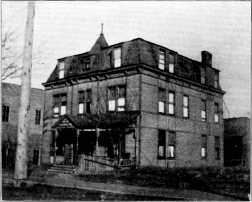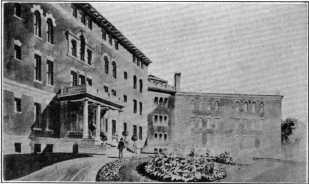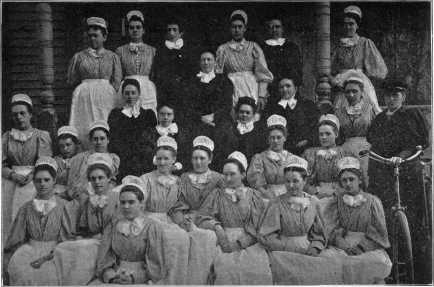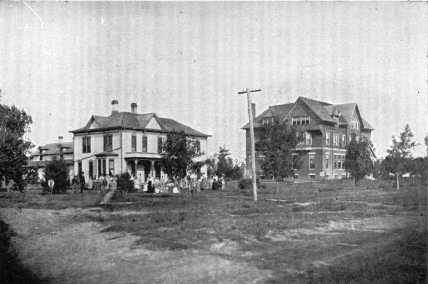
CHAPTER XXVI.
FOURTH PERIOD. (1880-1904.)
SOME SUBORDINATE AGENCIES AND INSTITUTIONS.
IT could
not be otherwise than that the religion established by our Lord,
who Himself was constantly ministering to the whole man, feeding
the hungry, healing the sick, instructing the mind, and pardoning
the guilty and regenerating the soul, should take on all the
manifold forms required by human nature, and continue to minister
to the whole man. Then the generous impulses that are generated in
the hearts of his disciples, eliminating selfishness, impelling by
their gentle pressure, guided by an intelligent perception of the
need, must soon find expression in suitable agencies and
institutions for carrying on these larger features of Christian
work, and found a hospital for the sick.
It is among the pleasant recollections of the
writer that, when pastor of the First Church, South Omaha, in
1890, at one of our preachers' meetings, Dr. D. A. Foote, of
Omaha, came before us and presented the matter for the first time,
and the truth of history requires the statement that the inception
of the movement is due to Dr. Foote. A committee was appointed and
the agitation began and through varying stages of careful,
prayerful consideration, culminated in a tangible form the
following year.
508

THE OLD METHODIST HOSPITAL AT OMAHA

THE NEW METHODIST HOSPITAL AT OMAHA.
509
|
510 |
HISTORY OF NEBRASKA METHODISM. |
That the matter should be approached
cautiously, step by step, with no little hesitancy, and even some
honest opposition, was to be expected, for Omaha Methodism was yet
under the burden of debt, and ill prepared to assume further
financial responsibility.
The progress of this movement toward its blessed
consummation is so well told by Brother Haynes,* that I again
quote him: "The making of a beginning was held in reserve for the
time being till the matter might be further investigated. The most
inquisitive were on the alert seeking the while information. An
opportunity came unsought. Mrs. Lucy Rider Meyer, of Chicago, who
is reputed as the founder of training schools for nurses in the
Methodist Church, accompanied by her husband, on their way to
Denver, visited Omaha, and presented in a meeting held in the
basement of the First Methodist Church, some of the features of
the work necessary to the organization of a hospital. This
beginning was the occasion of all effort to commenced work looking
to the establishment of a hospital and Deaconess Home in this
city. The intelligent and satisfactory presentation of the case by
these zealous advocates gave inspiration to not a few, and
particularly the women present were aroused so thoroughly as to
incite them to greater deeds.
The women - Mrs. Haynes, Mrs. Claflin, Mrs.
Austin, and Mrs. Bryant - pressed the matter with such earnestness
and solicitude that the pastors changed their purpose as much as
to agree that if $1,500 should be raised as a guarantee of
success, they would make no further opposition. Dr. J. W. Shenk
courageously sec-

MRS. ALLIE P. McLAUGHLIN, SUPERINTENDENT, AND TWENTY-FIVE OTHER DEACONESSES OF THE OMAHA HOSPITAL AND DEACONESS HOME.
511
|
512 |
HISTORY OF NEBRASKA METHODISM. |
onded the presiding elder and the women in an endeavor to
make a trial.
In the meantime Dr. Gifford, who was the owner
of an infirmary on South Twentieth, near Harney Street, learning
of the effort being made, offered the building which he had
erected at his own expense, on the condition of an indebtedness of
$1,900 being assumed and that there be six rooms reserved for his
patients - two for men and two for women, and two besides,
subject, however, to the rules of the hospital. The Hospital
Association accepted the proposition, and leasing the ground at
$400 a year, opened the institution on May 28, 1891, for the
reception of patients.
On the same day and at the same place, the
association met and effected a permanent organization by electing
Dr. J. W. Shenk president, and J. C. Cowgill secretary. A
constitution was adopted, and a committee appointed to secure the
legal incorporation of the association. The name given the
institution is the Methodist Hospital and Deaconess Home of Omaha.
On May 24th, the hospital and home were dedicated by Bishop John
P. Newman.
"The opening of the hospital," says the Omaha
Christian Advocate, "is an event of great interest. The
association now owns property worth $10,000, on which there is an
indebtedness of $1,900. There has been about $1,500 subscribed for
current expenses. The building has capacity for twenty-eight
beds."
From the date of the opening till the present a
continuous good work has been done in caring for the sick, maimed,
and otherwise disabled ones. But the work of caring for such as
are admitted to the hospital can not
|
HISTORY OF NEBRASKA METHODISM. |
513 |
be done without expense; and provision had to be made to
meet the constantly accumulating outlay. To meet this in part, it
was deemed wise to make an inducement for friends and citizens to
contribute a small sum by offering an equivalent. Hence, any one
in health who may pay into the treasury ten dollars at one time is
entitled to a yearly membership ticket, which allows the
contributor, in case of personal sickness, to be taken care of
without charge, during the year of making the payment."
The growth and history of this blessed work are
thus briefly, but eloquently, summarized by Mrs. Allie P.
McLaughlin, who has been superintendent from the first: "The
Hospital and Deaconess Horne Association was organized thirteen
years ago this March. We opened the hospital the 28th day of May,
1891. We began to receive our patients without any means on hand,
but the Lord has so prospered us, we have taken care of more than
nine thousand people, of whom one-third have been entirely free.
And to-day we have no debt. Our little deaconess family of workers
numbered three at first, but now numbers forty-seven. We have been
very much cramped all of these years because of our limited
quarters. Thousands have been turned from our doors because we
could not receive them for lack of room.
The spiritual part of this work is one of the
leading features, all of the workers being Christian people. The
hospital itself is a great mission field. There have been a great
many conversions as the months and years have gone by.
The new building is now begun, the site paid for
and about half enough for a $110,000 building. Of the first
|
514 |
HISTORY OF NEBRASKA METHODISM. |
workers who came thirteen years ago, two of us yet
remain, Miss Jennie Cavanaugh and myself."
While under Methodist auspices, its beneficence
is not confined to Methodist people, as will be seen by the
following figures of a year's work, as appears from the annual
report for 1901-02: No Church, 235; Methodist, 231; all other
denominations, including sixty-three Catholics, 420.
Besides the nursing in the hospital, involved in
the care of these patients, these nurses spent 26,872 hours in
nursing patients outside of the hospital.
On the lines of spiritual work they have
visiting deaconesses, and many of our pastors will bear cheerful
witness to their helpfulness in revival-meetings, and other forms
of work.
Their staff of physicians and surgeons include
some of the most skillful in the country. Their names are: Harold
Gifford, A. F. Jonas, J. C. Moore, W. O. Bridges, W. S. Gibbs, H.
M. McClanahan, J. M. Aikin, R. S. Anglin, O. S. Hoffman, W. K.
Yeakel, D. A. Foote, S. J. Quimby, and Mrs. Freeda M. Lankton.
MOTHERS' JEWELS HOME.
Not only was the Church broadening the range of her activities and agencies so as to include the hospitals, but the same generous impulse led her to take steps to provide for homeless children. In this site shared a general movement in this direction which set in about this time which was not only the result of a charitable impulse, but the intelligent perception of an urgent need that such children should be cared for and nurtured tinder favorable influences, lest they grow up without any training, or what is worse, vicious training.

THE MOTHERS' JEWELS HOME.
515
|
516 |
HISTORY OF NEBRASKA METHODISM. |
Moved by this impulse, Dr. W. L.
Armstrong, M. D., had already dedicated his one hundred and sixty
acre farm in Platte County, Nebraska, to that purpose, and had
been caring for a few children as best he could. But the movement
did not become very efficient, or command the support necessary to
success. But Dr. Armstrong had his heart set on this noble
project, and the Heavenly Father soon opened the way to much
larger things. Coincident with this intense desire on the part of
Dr. Armstrong to do something along this line, there was a growing
conviction among the leaders of the Woman's Home Missionary
Society that they ought to enter this field, and were already
casting about for a suitable place to establish a national
orphanage. Just at this juncture Mrs. Spurlock, who had been
elected a delegate to the meeting of the National Board of
Managers, who were to act on this matter at their next meeting,
proposed to Dr. Armstrong that he join forces with the Woman's
Home Missionary Society and that they work together for the object
that had come to be so dear to both. To this he readily consented,
and with this leverage, Mrs. Spurlock's earnest and eloquent plea
won the day, and it was decided by the Board of Managers to locate
their institution in Nebraska, and soon after that York was
selected as the site. Dr. Armstrong giving his $3,000 farm and the
York people adding $7,000, a fine farm of 160 acres adjacent to
the city of York, worth then $10,000, was purchased and the
Mothers'Jewels Home began its beneficent career.
As seemed most fitting, good Dr. Armstrong was
placed in charge, but he was already growing old and enfeebled by
ill health, and soon found the work too hard,